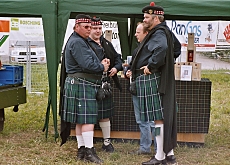
Swiss get into Highland spirit

The fourth "Wùy ù Ay" Highland Games has taken place in St Ursen, canton Fribourg, offering traditional Scottish music, whisky and of course caber-tossing.
More than 9,000 Swiss lovers of Scotland gathered over the weekend to cheer on kilted athletes and bagpipe-wielding musicians in various competitions.
Stefan Piller, a spokesman for the festival, explained how a Swiss-Scottish cultural association was founded in 1999 by two Swiss who had been to Scotland several times on holiday and had “fallen in love” with the culture.
“They began organising various concerts and whisky tastings and so on and soon found that people would also like something broader. They then thought of organising the first Highland Games in Switzerland,” he told swissinfo.
“Wùy ù Ay” is not Gaelic but in fact the local dialect, Senslerdeutsch, for “up and down”.
At first glance Switzerland and Scotland share obvious similarities – both are relatively mountainous and small (there are five million Scots compared with seven million Swiss) – but Piller sees other reasons that explain the “special relationship”.
“Both countries certainly have a distinct folk festival culture,” he said. “There are also stone-throwing festivals in Switzerland, such as the Unspunnenfest in September, which also feature folklore music – so there are definitely connections.”
Competitions
Just under 40 hardy competitors – five of them female – will be tossing and throwing various objects in the “heavy events”.
This includes the caber toss – where the idea is to flip a six-metre, 70-kilogram tree trunk (although the Swiss caber is slightly smaller), the stone put – similar to the shot put at the Olympic games, and the weight over the bar – where athletes attempt to lob a 25kg weight with a handle back over their heads and over a horizontal bar.
Some say the definition of a gentleman is someone who knows how to play the bagpipes but doesn’t. The 45 pipers and drummers in the solo and band competitions beg to disagree.
All competitors are Swiss or live in Switzerland, but Piller thinks he’s spotted a ringer. “There’s a French-speaking lady from Lausanne taking part but she’s got a British-sounding name so I suspect she’s originally from Scotland, but I can’t confirm that…”
Piller says the organisers are trying to attract more women. “We’re trying to make it known that women are welcome at the Games. Last year there was one female competitor and this year there are five.”
Something for everyone
He added that because it’s a family event – there’s a Scottish bouncy castle for kids, a whisky corner (not for kids) and a “Scotland Shop” – there’s something for everyone.
“It’s a folk festival atmosphere. There are young people, old people, sporty people, musical people – however the bagpipe competition is certainly very popular and the caber-tossing also generates a lot of interest,” he said.
“This is probably because stone-throwing is familiar to people in Switzerland and isn’t as technically demanding as tossing a caber, which very few people can actually turn.”
The popularity of the bagpipe competitions challenges the theory that the inventor of the bagpipes was inspired when he saw a man carrying an angry asthmatic pig under his arm.
Favourite tunes that will probably be heard drifting over the Alps are Scotland the Brave, Amazing Grace and the unofficial Scottish national anthem, Flower of Scotland.
swissinfo, Thomas Stephens
The 4th “Wùy ù Ay” Highland Games took place from August 25-27. The first championships took place in 2003.
9,000 spectators watched the 40 or so athletes and 45 musicians in various competitions.
The Unspunnenfest is a festival held in Unspunnen, canton Bern, roughly every ten years and which highlights traditional Swiss culture, including stone-throwing, wrestling and yodelling. The next festival will take place from September 1-3, 2006.
The games are held throughout the year in Scotland and many other countries as a way of celebrating Scottish and Gaelic culture and heritage, especially that of the Scottish Highlands.
Certain aspects of the games have become emblematic of Scotland, such as the bagpipes, the kilt and tossing the caber.
Apart from competitions in piping and drumming, dancing and “heavy events”, the games also include entertainment and exhibits on other aspects of traditional culture.
The games also played a role in the development of the modern Olympics. Founder Baron Pierre de Coubertin visited a number of Highland Games to determine which sports should be included, to standardise rules and to examine how to run such competitions.

In compliance with the JTI standards
More: SWI swissinfo.ch certified by the Journalism Trust Initiative






























You can find an overview of ongoing debates with our journalists here . Please join us!
If you want to start a conversation about a topic raised in this article or want to report factual errors, email us at english@swissinfo.ch.